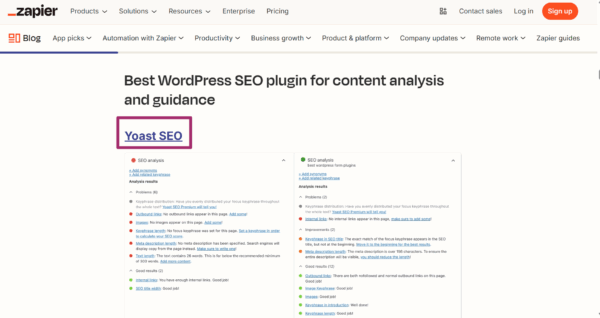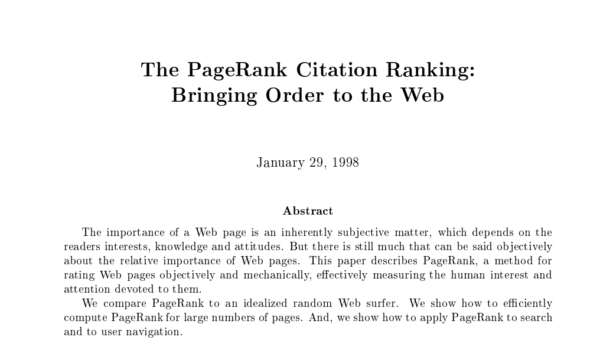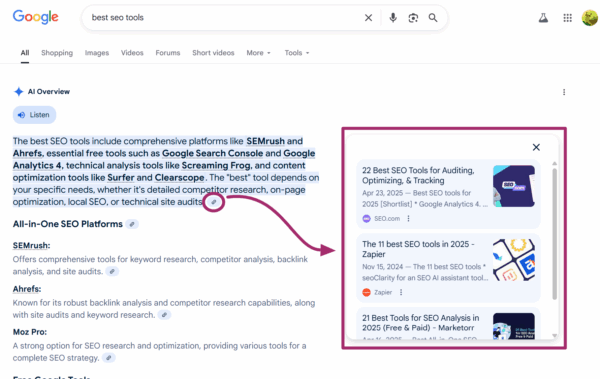Everything you need to know about AI citations vs backlinks

For years, backlinks have been the gold standard for building authority, driving link juice, and climbing up the SERPs. But with the rise of Generative AI, the search landscape is shifting. Instead of chasing endless links, visibility now also depends on something more intelligent: AI citations. This evolution means your brand can show up in front of wider audiences, even without a massive backlink profile.
The question is, when it comes to AI citations versus backlinks, how do they differ, and does one outweigh the other? In this blog, we’ll break down both, explore their role in building authority, and uncover whether AI citations are the future of digital visibility or just another layer to your SEO strategy.
What are backlinks?
Backlinks are simply links from one website to another. Think of them as digital recommendations: when a reputable site links to your content, it signals to search engines that your page is trustworthy and valuable.
For example, below is a screenshot from a Zapier blog post that links to the Yoast SEO plugin landing page in the blog.

Backlinks aren’t new; they’ve been around for more than two decades. In fact, links were introduced back in 1998 as part of Google’s original PageRank algorithm, making them one of the oldest forms of online citations. Since then, they’ve remained a core ranking factor, shaping how websites compete for visibility.

Today, backlinks are still considered one of the strongest signals for building authority. Many brands invest in link-building strategies to secure high-quality backlinks, from being cited in well-written pieces to building relationships that earn natural mentions.
Why backlinks matter?
Backlinks are not just about search rankings, but they influence almost every aspect of your website’s visibility and growth. Here’s why they remain essential:
- Improve rankings by acting as one of Google’s most important signals, especially when they come from authoritative domains
- Drive referral traffic that is often highly targeted and more likely to engage with your content
- Boost authority and credibility by showing search engines that trusted sites vouch for your content
- Help with faster indexing by guiding search engine crawlers to discover and prioritize your pages
- Provide semantic understanding by giving Google context through anchor text and linking page content
What types of backlinks work best?
Not all backlinks are equal, and the ones that matter most usually have these traits:
- They come from trusted and authoritative websites
- They include your target keyword or a variation of the target keywords in your anchor text
- They are topically relevant to your niche
- They are ‘dofollow’ links that pass link equity
Backlinks remain important for SEO, but as search evolves, they’re no longer the only way to build authority. This is where AI citations enter the picture.
Read more: Link building from a holistic SEO perspective
What are AI citations?
AI citations are references, attributions, or direct links to your content, brand, or product that appear within AI-generated answers. Unlike traditional backlinks that live inside web content, AI citations are shown within AI search results or summaries. They often appear as clickable source cards, numbered footnotes, or links listed below an AI overview.
For example, when Google AI Overviews quotes websites in the AI search box, it cites the original sources that provided the information.

Some other examples of AI citations are:
- ChatGPT cites your brand or content as part of its generated answer
- Bing Copilot highlights your product as a recommended solution to a user’s query, even if it doesn’t include a direct link
- Perplexity.ai lists your research as a supporting source beneath its summarized response
Why AI citations matter for visibility?
AI citations are becoming critical for brand exposure because they align with how people now consume information online:
- Search is becoming prompt-driven, which means users type questions or prompts instead of keywords. If AI picks your content to cite, you’re instantly visible to that audience
- Discovery is moving from clicks to context. Users may not always visit your website, but being cited ensures your brand becomes part of the answer itself
- AI is becoming your audience’s first impression. In many cases, people see the AI summary before they see the actual search results. Appearing as a cited source makes your brand part of that first interaction
- Citations boost credibility and authority. When an AI tool references your content, it signals to users that your site is trustworthy enough to be part of the response
Types of AI citations that influence brand visibility
Not all AI citations look the same. Here are the key forms that shape how your brand is discovered:
Name-drop mentions drive brand visibility
When AI directly mentions your brand or product in its response, such as in a recommendation or ‘best of list, you gain instant visibility in front of users without them needing to click further.
Source references build credibility signals
These citations work like the ‘works cited’ section in AI outputs. Tools like Gemini, Perplexity, or Google AI Overviews may display your URL in the list of sources at the bottom of the response. Even if you’re not in the main summary, you benefit from the authority signal.
Quoted passages establish expert authority
When AI pulls exact wording from your content and attributes it to you, it elevates your position as an expert. This type of citation places you in prime digital real estate, signalling leadership in your niche.
Synthesized mentions shape brand narrative
Sometimes AI blends your insights into its summary without naming or linking back to you. While harder to measure, your content still influences the narrative and reinforces brand authority in indirect ways.
AI citations are already reshaping how visibility works in search. Just as backlinks defined SEO two decades ago, citations in AI search are now shaping brand perception by influencing what users see, trust, and remember about your business.
How are AI citations and backlinks different?
So, now that we have an overview of AI citations and backlinks, let’s see how backlinks and LLM citations differ from each other -`
| Aspect | Backlinks | AI/LLM Citations |
| What they are | Hyperlinks from one website to another, long used as a ranking factor in SEO | Mentions, attributions, or references included in AI-generated answers, sometimes with clickable links |
| Visibility | Usually embedded within web content and not always visible to the average reader | Front-facing and displayed in AI overviews, chatbots, or search snapshots, making them highly visible to users |
| Trust impact | Boosts site authority indirectly through improved rankings and referral signals | Builds direct credibility by being presented as a trusted source in AI answers or summaries |
| Selection factors | Determined by domain authority, anchor text, and contextual relevance | Google AI Overviews, citing your blog |
| Examples | A news site links to your product page in an article | Link building strategies, such as outreach, partnerships, and content marketing, to earn quality backlinks |
| SEO focus | Link building strategies, such as outreach, partnerships, and content marketing, to earn quality backlinks | Creating structured, high-quality, and easily digestible content that AI systems can cite |
| Effect | Improves rankings and drives referral traffic over time | Enhances brand visibility, authority, and recall directly in AI-powered search experiences |
How to earn both?
Earning backlinks and AI citations doesn’t have to be two separate strategies. With the right approach, the same efforts that build traditional authority also make your content LLM crawler-friendly.
Here’s how to do it:
Create deep, original, and useful content
Go beyond rewriting what’s already ranking. Publish original research, case studies, interviews, or unique perspectives that others can’t find elsewhere. AI models pull from fresh, problem-solving content, and so do journalists and bloggers who link naturally.
Write for real questions, not just keywords
Search is shifting from keywords to prompts. Pay attention to what your audience is actually asking on forums, social media, and other platforms. Create conversational, direct answers to those questions. If your content aligns with user prompts, it’s far more likely to be both cited by AI and linked by humans.
Leverage structured data
Use schema markup (FAQ, HowTo, Article, Product) to help AI and search engines clearly understand your content. Proper attribution of authors and sources also increases your chance of being recognized as a credible reference. Structured, transparent content is ‘citation ready.’
Build relationships for natural backlinks
Backlinks remain relationship-driven. Connect with journalists, bloggers, and industry peers through guest posts, expert roundups, or collaborations. AI often mirrors human trust signals, so if authoritative voices link to you, AI is more likely to cite you too.
Focus on clarity and quotability
Make your content easy to lift and reuse. Use short, memorable statements, stats, or definitions that can be quoted word-for-word. Structured layouts like subheadings, lists, and bullet points make content easier to reference by both humans and AI.
Monitor, analyze, and adapt
Don’t just publish; instead, track performance. Use SEO tools for backlinks and platforms to monitor AI citations and understand AI brand perception. If competitors are cited for prompts you should own, study their structure and improve on it. Adjusting based on data helps you stay ahead.
The takeaway: With the right strategies, you don’t need separate plans for backlinks and AI citations. Clear, authoritative, and trustworthy content earns both and multiplies your visibility across search engines and AI-powered platforms.
Exploring Yoast’s AI features
Applying the right strategies for earning backlinks and AI citations is easier when you have the right tools. Yoast’s AI features combine SEO best practices with AI-powered enhancements to make your content clearer, more discoverable, and more effective.
Here’s how they can support your workflow:
Yoast AI Generate
Quickly create multiple, tailored titles and meta descriptions for your pages or blog posts. This ensures your content attracts clicks and stands out in search results. You can select from different options, tweak them to fit your brand voice, and preview how they’ll appear in SERPs.
Yoast AI Summarize
Turn long-form content into scannable, bullet-point takeaways in seconds. This may also help reduce bounce rates by giving readers immediate clarity on what your page delivers. It also makes your content easier for AI systems and Google’s AI Overviews to interpret correctly.
Yoast AI Optimize
Get AI-powered suggestions to improve SEO signals such as keyphrase distribution, sentence length, and readability. You can review, apply, or dismiss recommendations with one click, ensuring that optimization never comes at the cost of your unique editorial voice.
Together, these AI-powered features help you save time, improve clarity, and boost both human and AI-driven visibility, laying the foundation for stronger backlinks and more consistent AI citations.
Want to take it a step further? Introducing Yoast AI+, designed to help your brand stay visible and accurate in the era of AI search.
See how visible your brand is in AI search
Track mentions, sentiment, and AI visibility. With AI Brand Insights and Yoast SEO AI+, you can start monitoring and improving your performance.
Backlinks or citations: What truly matters for visibility?
Backlinks have been the backbone of SEO for more than two decades, helping websites climb rankings, build authority, and attract referral traffic. But the rise of AI citations is reshaping how visibility works. When AI systems like Google’s AI Overviews or ChatGPT cite your content, they place your brand directly in front of users at the moment of discovery.
The truth is, it’s not a choice between backlinks and AI citations. Both matter, but in different ways. Backlinks remain critical for SEO growth and authority, while AI citations are quickly becoming the new gatekeepers of brand perception and visibility. The winning strategy is to create content that earns both.

